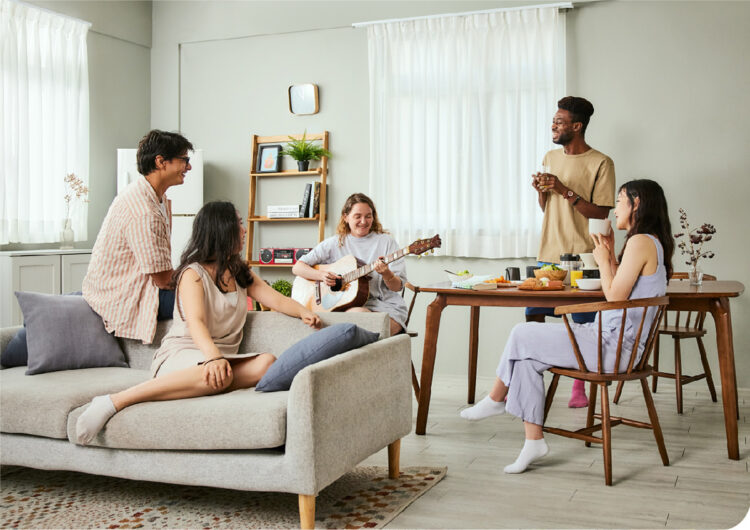Los Angeles stands as a vibrant hub of culture, innovation, and diversity. However, it also grapples with a significant rental crisis characterized by high costs and limited availability. As residents and policymakers search for solutions, co-living emerges as a promising alternative.
This model offers shared living spaces that typically include furnished communal areas and private bedrooms, aiming to make urban living more affordable and social.
For a closer look at how apartment-share is shaping up in the City of Angels, especially in bustling areas like Koreatown, check out these Koreatown LA apartments.
Page Contents
Key Takeaways
- Co-living provides an affordable, social housing option in high-cost areas.
- Privacy is maintained through private bedrooms, balancing community and personal space.
- While beneficial, it is not a standalone solution for LA’s diverse housing needs.
Why Consider Co-Living in LA?
The charm of apartment-share in Los Angeles lies not just in affordability but also in its community-centric approach. Residents often enjoy the benefits of lower rent prices due to shared spaces, which include kitchens, living rooms, and sometimes even bathrooms.
This arrangement allows individuals to live in prime urban locations without bearing the brunt of exorbitant rental costs alone. Moreover, utilities, WiFi, and cleaning services are typically included in the rent, simplifying budgeting for tenants.
The Social Dimension

Source: harringtonhousing.com
One of the most significant advantages of co-living is the built-in community it offers. In a city as vast and sometimes isolating as Los Angeles, apartment-share spaces provide a social network right at home.
These environments foster interactions and friendships among residents who share common areas and, often, similar interests or lifestyles. For many, this aspect of apartment-share can greatly enhance their quality of life in the city.
What Does It Mean for Privacy?
While the social perks of co-living are appealing, potential residents often question the privacy in such settings. Each co-living facility varies, but most offer private bedrooms, allowing for personal space and retreat.
Common areas are shared, which can be a shift for those used to living alone. However, most co-living residents find a balance between social interaction and personal privacy, embracing the communal living model while maintaining their own space.
Co-Living and LA’s Rental Market
Co-living impacts the rental market by providing more housing units within the same footprint as traditional apartments. This efficiency can help alleviate some of the housing shortages in Los Angeles.
Additionally, by offering more affordable rents, co-habitation can relieve the financial pressure on renters, potentially driving down demand in traditional rental markets and stabilizing prices across the board.
Can It Truly Tackle LA’s Housing Issues?

Source: hlwc.fr
While co-living offers many benefits, It’s not a one-size-fits-all solution to LA’s housing crisis. It caters primarily to singles or couples without children, leaving out a significant portion of the population in need of family housing.
Moreover, the success of apartment-share in alleviating rental market pressures largely depends on its scale and the continued willingness of residents and developers to embrace this model.
The Future Prospects
As urban populations continue to grow and the demand for affordable housing intensifies, co-living could play a crucial role in LA’s housing ecosystem. Its ability to blend affordability with social opportunities makes it particularly attractive to young professionals and new residents.
With proper regulation and support from the city, cohabitation has the potential to expand and adapt to accommodate a broader range of residents.
FAQs

Source: startupper.gr
What is co-living exactly?
It involves living with others in a shared space where common areas are communal, but private bedrooms provide personal space, often with utilities and services included.
Is co-living more affordable than traditional renting?
Yes, it typically offers lower rental prices since costs for shared spaces and utilities are divided among residents, making it a cost-effective option.
Who typically chooses co-living?
This way of living often attracts young professionals, digital nomads, and newcomers to the city looking for affordable living options and a built-in community.
How does co-living impact the local rental market?
It can help alleviate housing shortages by increasing the number of available units and providing more affordable rental options, potentially stabilizing market prices.

Source: wohnglueck.de
Conclusion
Co-living represents a modern, community-oriented solution to some of the challenges posed by Los Angeles’s rental market. It offers both social and financial benefits, making it an attractive option for individuals and couples looking to enjoy city life without the high cost.
While it won’t solve every issue related to housing in LA, its role in the broader tapestry of housing solutions is undeniable. As we move forward, the flexibility and community-centric approach of this way of living may become even more relevant, shaping how new generations think about and engage with urban living.





